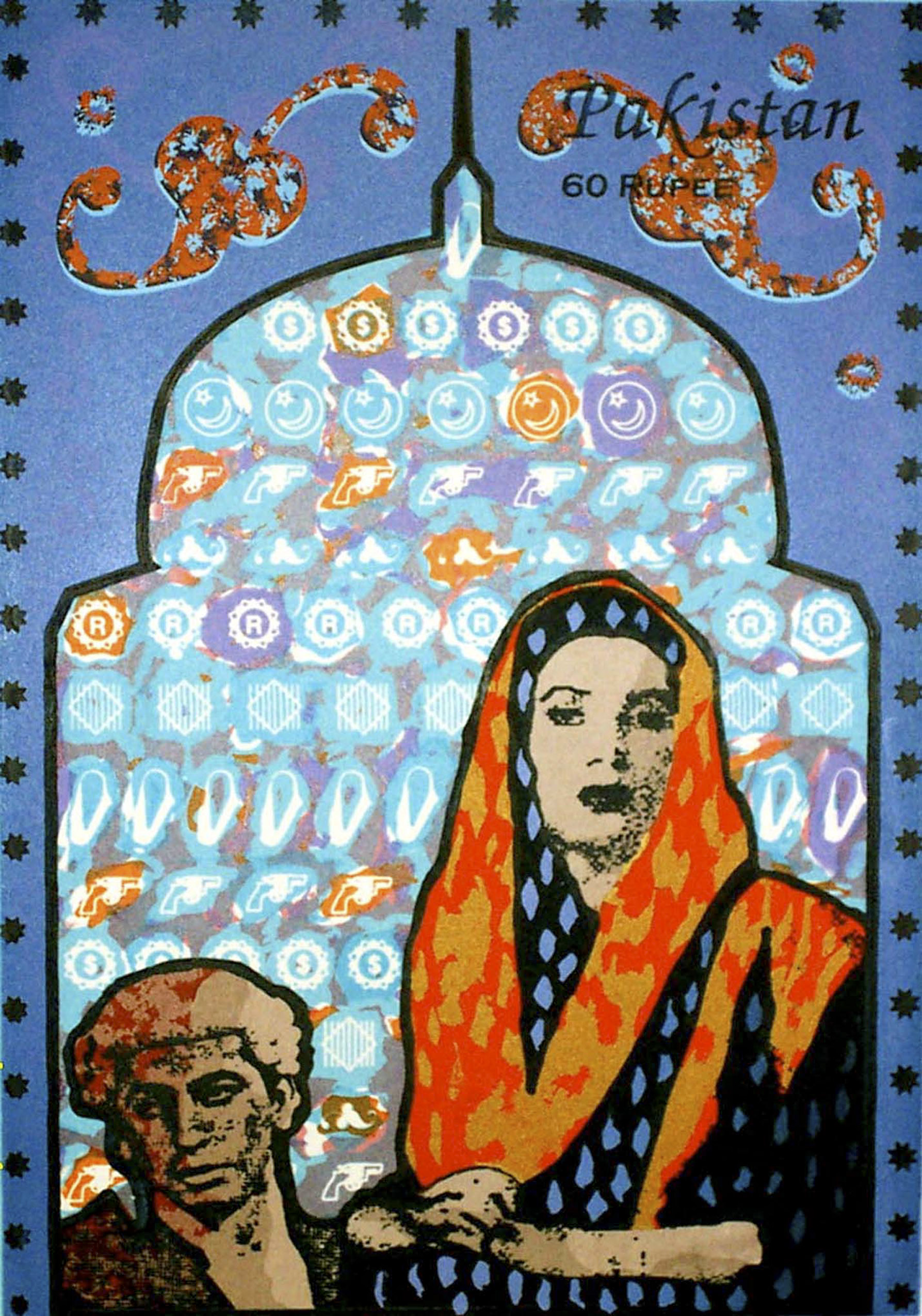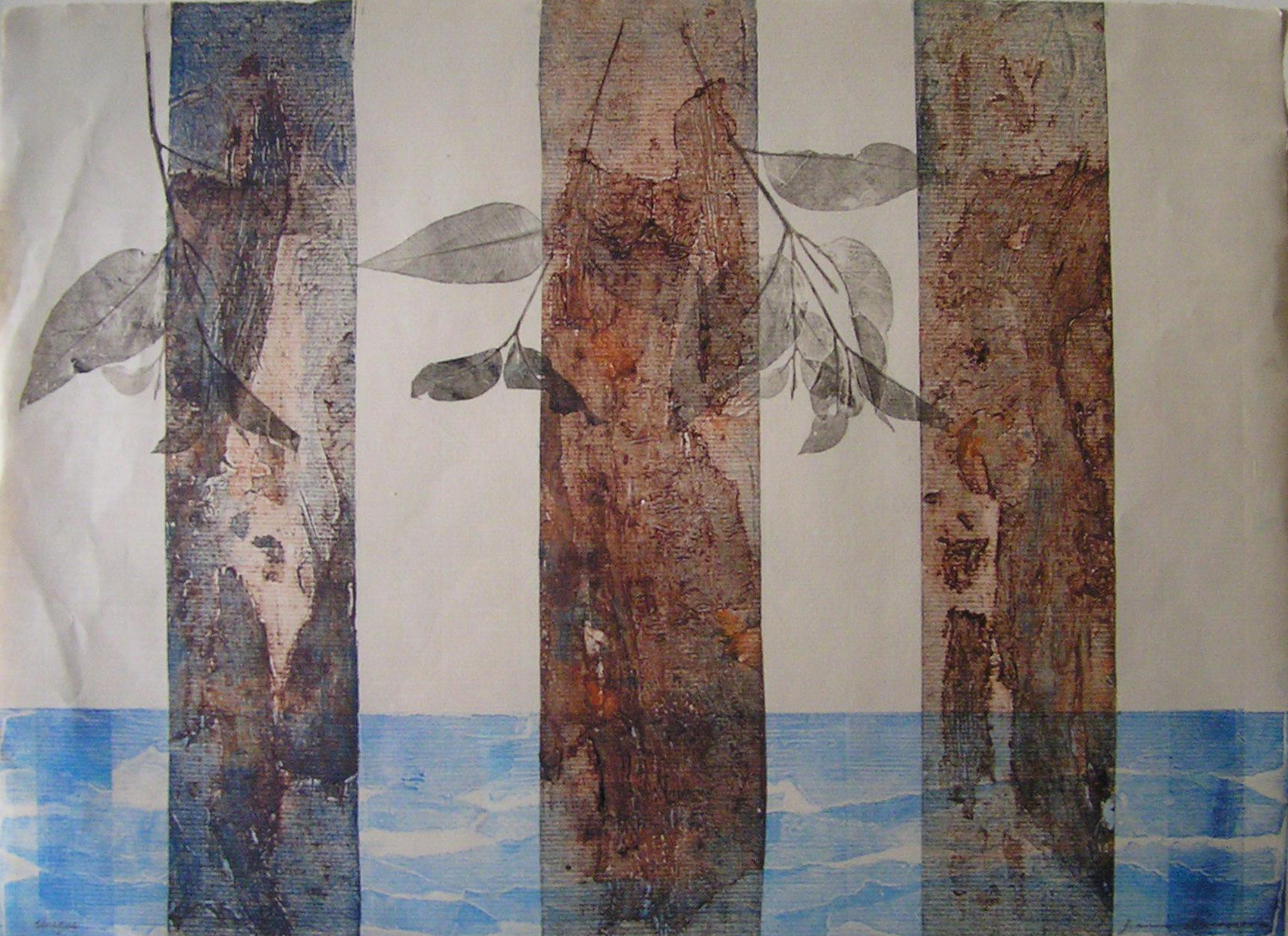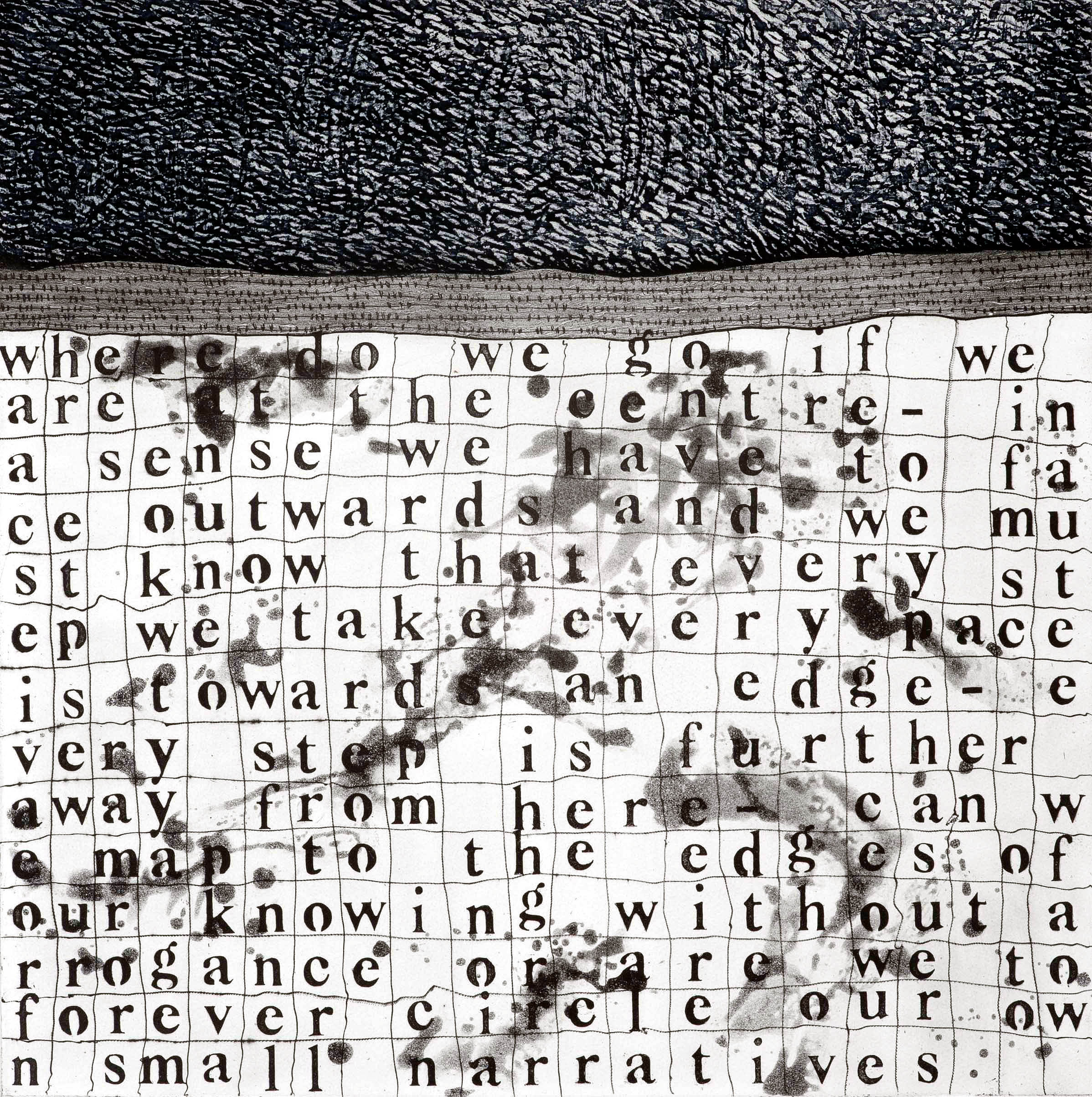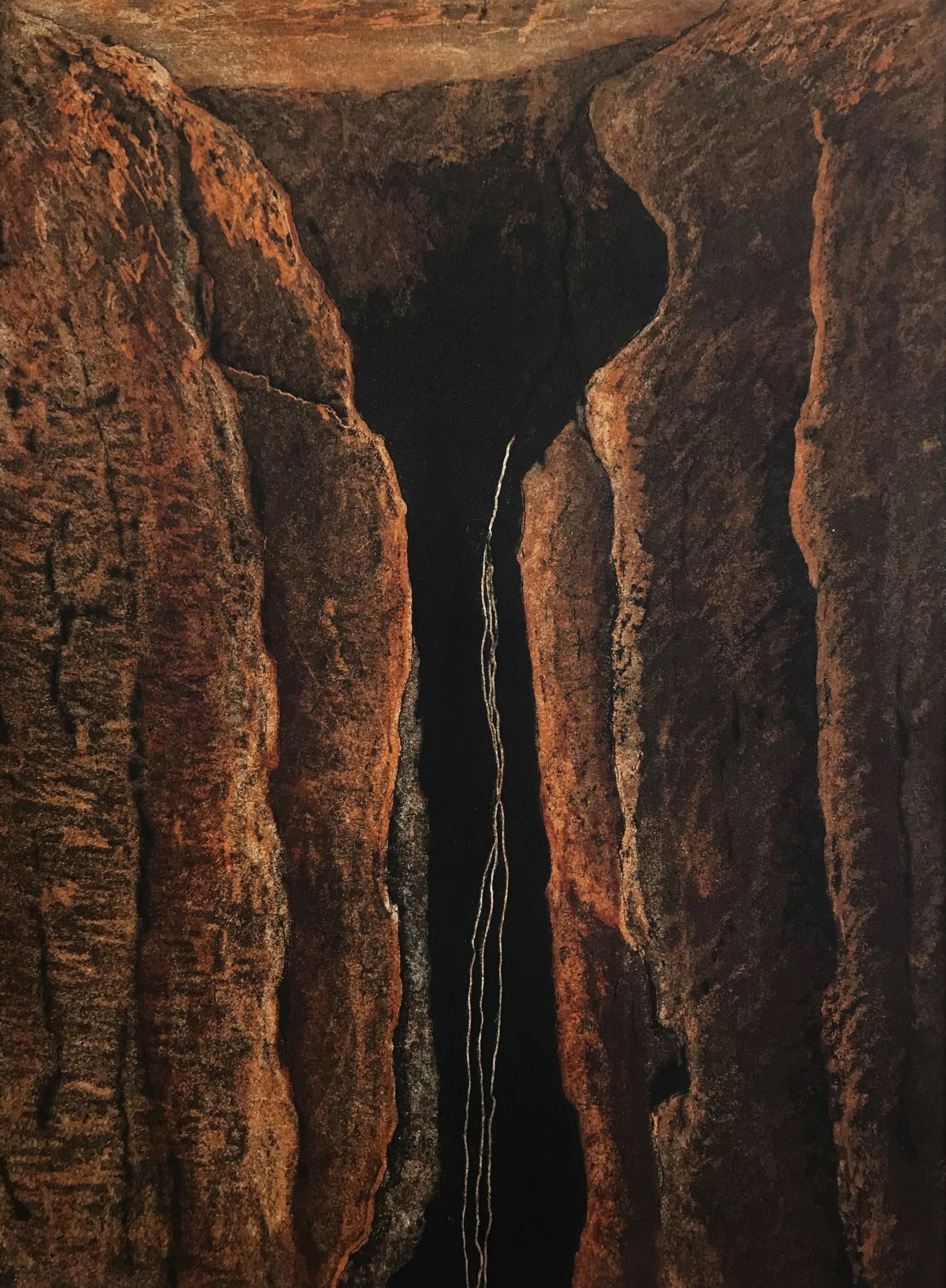From top, artist exhibiting in 40/40:
Marie-Therese Wisniowski, Veiled Curtains: Benezir, 2002, screenprint on Stonhenge paper, 76 x 56 cm
Jeanne Harrison, From Nature, 2006, collagraph, 30 x 40 cm
Patricia Wilson-Adams, From the Centre – squared, 2013, intaglio, spit bite and aquatint, 50 x 50 cm
Michelle Hallinan, Tenacious Life, 2018, Intaglio, 29.5 x 21.5 cm
Open access printmaking workshops are rare in Australia. However Newcastle has had the good fortune of being home to Newcastle Printmakers Workshop (NPW), which has achieved the significant milestone of turning forty this year. Over this time NPW has provided the opportunity to access printmaking facilities which would otherwise only be available in a university, college or private studio. The workshop has had highly successful community collaborations and exhibitions which are documented in their extensive archives, now stored in the Local History Library of Newcastle.
Two core principles of NPW are accessibility and education. The workshop runs courses to expand the skills of members as well as introducing printmaking to the general public. NPW is a valuable asset in Newcastle, where graduates can continue their practice independently after completing their studies.
Three founding members, Therese Kenyon, Patricia Wilson-Adams and Birgitte Hansen, are participating in a fortieth anniversary exhibition this November, called 40/40. In recent interviews, they reflected on their own involvement in establishing the longest-running open access printmaking workshop in Australia.
Therese Kenyon is an artist/curator and writer with extensive experience in artist projects. Her present studio in the Addison Road Community Centre, Marrickville, is part of a group which has the sole philosophy of providing a cheap space for artists. Forty years ago, this type of pragmatism was the initial motivation for Kenyon to become involved in the founding of NPW. A former student of Patricia Wilson-Adams, Kenyon had just completed a residency at Griffith University and needed enough space to make large prints as well as a place where she could realise her ideas for collaborations. One of those ideas was the project East End – Before and After.
In the mid-1980s, Kenyon directed more than twenty artists in a two-year community project about Newcastle East, an area which was under threat from development. The project began with the idea of getting residents to make prints about their environment, history and lives. Residents of this most historic part of Newcastle as well as the Awabakal Aboriginal Cooperative became printmakers and made visual documentation of the experiences of the residents.
The project culminated in an exhibition of eighty prints, 200 photographs, slides, video, two large banners, postcards and T-shirts depicting aspects and monuments of Newcastle East and a sixty-page catalogue book. The project contributed another voice to the planning of the redevelopment of this area. The exhibition was shown in Newcastle Art Gallery, the Experimental Art Foundation in Adelaide, and the Tin Sheds, University of Sydney, before being purchased by the National Gallery of Australia. The East End project raised the public profile of NPW and also raised funds through the sale of the exhibition to the National Gallery. This was just one of many projects which established NPW as an important community based place.
Patricia Wilson-Adams is an artist who spent thirty years as an academic at the University of Newcastle (formerly Newcastle College of Advanced Education). She spoke about large projects galvanising members of NPW to work together with the community. Wilson-Adams also noted that NPW is not only a culturally important place for the community but it is also a very important place in the lives and artistic practices of individual members. Returning from France after working there from 1969 to 1972 with S. W. Hayter at Atelier 17 in Paris, Wilson-Adams knew what a shared workshop was like and understood how it had influenced herself and her work. As an academic at the University of Newcastle, she saw the need for her students to have a place where they could work independently after graduating. She describes her motivation for supporting the workshop as “initially idealistic – for students, so that they had a trajectory”. Her own trajectory of artistic expression moved beyond editioning fine-art prints on paper to exploring the expanding definition of a print using non-traditional materials and techniques.
Describing herself as a working artist, Birgitte Hansen’s home is brimming with large, colourful paintings as well as etchings, all carefully executed. “I tell my stories in my work”, she says. On her bookshelves are albums documenting her extensive commissions for public art murals and trade union banners. After graduating from Newcastle College of Advanced Education, and with a strong sense of wanting to pay her own way, Hansen started earning money from teaching etching to the general public at the Society of Artists. Coming out of the supportive environment of art school, the Society of Artists provided a space where she could work autonomously and have support in achieving her goals. However, the Society of Artists was facing the looming threat of eviction and difficulties finding premises large enough to accommodate everyone.
The formation of a separate printmaking organization was proposed, which was named by Birgitte as Newcastle Printmakers Workshop. But it was Hansen’s community art practice which was where she says she “found my people, found my space”. Commissions for murals, banners and large scale paintings started to provide Hansen with a main source of income so she stopped printmaking.
In the archives of the minutes of NPW meetings, formal thanks are recorded from the first Chairperson of the newly inaugurated Newcastle Printmakers Workshop, Rob Winston, to Hansen “for all her hard work and for initiating this whole workshop”[1]. Reflecting on the longevity of NPW, Hansen said: “There wasn’t a sense of establishing something that would last this long. It was just what we needed for ourselves at the time.”
—
Notes:
[1] Winston, R. Meeting Minutes Inaugural Meeting of Newcastle Printmakers Workshop: Newcastle Printmakers Workshop Archive. Box 6. Newcastle Region Library, War Memorial Cultural Centre, Newcastle. Accessed 2019, July 11.
—
Links:
https://soundcloud.com/uoncc/newcastle-printmakers-workshop-robin-winston-26-aug-1989
—
The group exhibition 40/40 opens 9 November at Art Systems Wickham. www.newcastleprintmakersworkshop.org.








